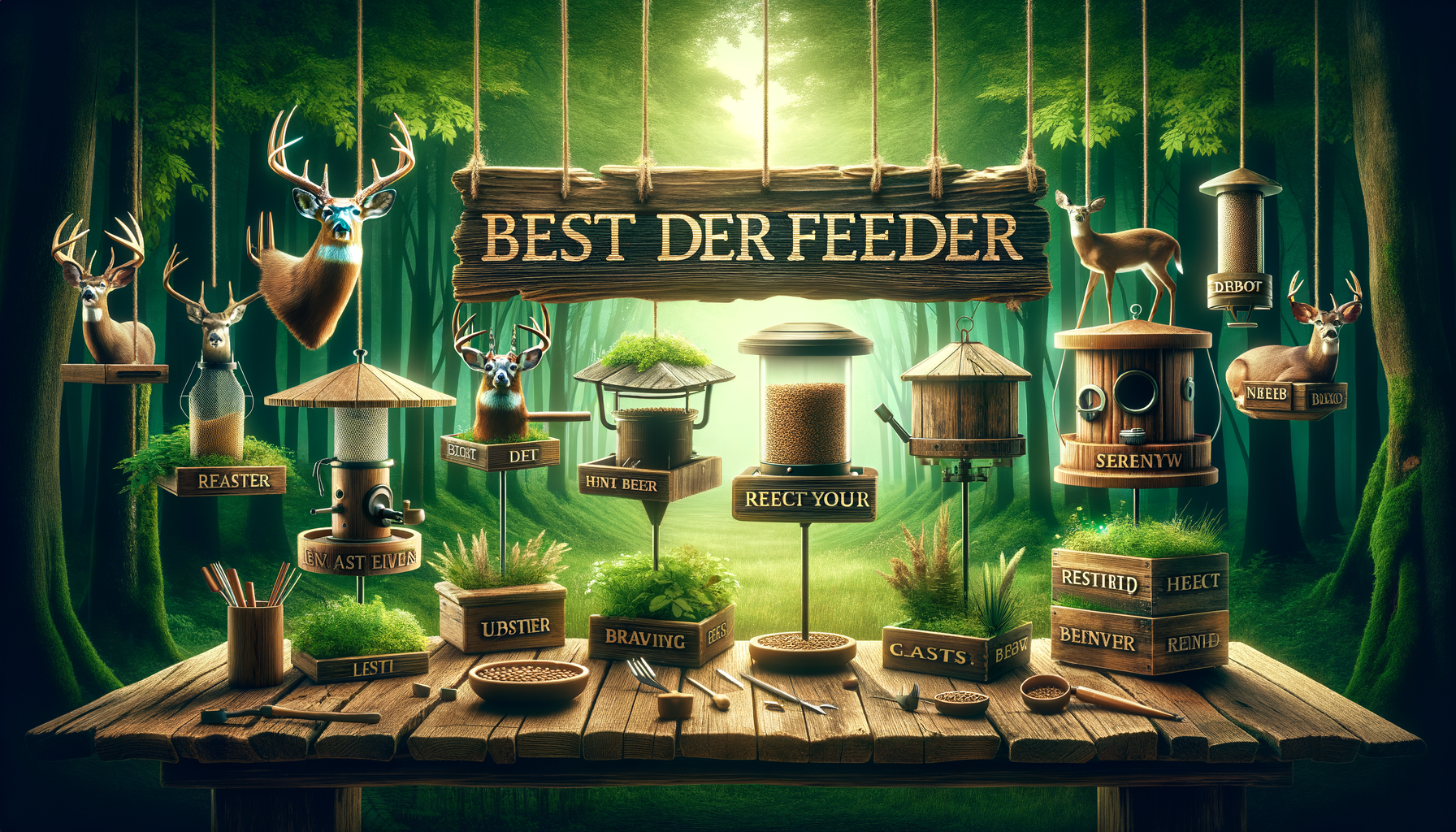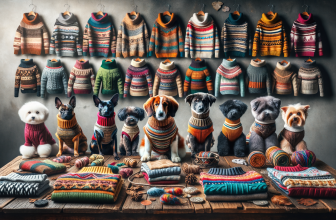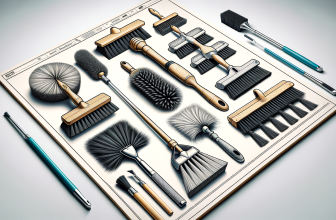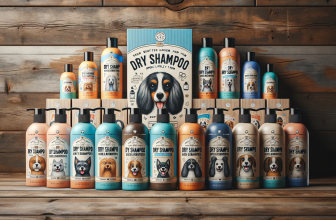
Have you ever had that fleeting moment of excitement when a deer wanders into view, only for it to disappear seconds later, leaving you wishing for a longer wildlife encounter? What if there was a way to reward your patience and enhance your chances of regular sightings? Deer feeders are designed for that very purpose—to entice these majestic animals into your viewing range and keep them around for a bit. But with so many options on the market, how do you choose the best deer feeder?
Our Top Picks
Our #1 Top Pick: Moultrie Deer Feeder Pro
The Moultrie Deer Feeder Pro is a stellar option for anyone looking to attract deer with a reliable and durable feeder. It comes with a sturdy metal spin plate and funnel which ensures a smooth feed flow without any clogging. This model has an impressive 30-gallon hopper that can store plenty of feed, reducing the need for frequent refills. The digital timer allows for up to 6 feed times per day, ranging from 1-20 seconds each, giving you complete control over feeding schedules. Moreover, its built-in varmint guard ensures that your feed stays safe from pesky raccoons and other unwanted critters.
Pick #2: American Hunter Sun Slinger Directional Feeder Kit
Second on our list is the American Hunter Sun Slinger Directional Feeder Kit. This feeder stands out with its built-in solar charger, ensuring that the battery is constantly recharged during the day, thus prolonging the feeder’s service. Its directional shroud directs the feed into a narrow path, which is perfect for setting up along a trail or feeding path. Additionally, it features an easy-to-set digital timer with adjustable feed rate intervals from 1 to 30 seconds. This is a great fit for those who need a self-sustaining feeder that minimizes maintenance.
Pick #3: Wildgame Innovations Quick-Set 225
Ranking third, the Wildgame Innovations Quick-Set 225 is a solid choice for deer enthusiasts looking for both capacity and convenience. With an impressive 225-pound capacity, this feeder can hold enough feed to last for weeks. It features a durable poly barrel design and a robust galvanized steel spinner plate. The digital timer offers flexible feeding options that can dispense feed up to 4 times a day. Set-up is straightforward with an easy-to-follow instruction manual, making it a straightforward choice for both beginners and experienced users alike.
Pick #4: Capsule Feeders The Badass Auger Tripod Feeder
Taking the fourth spot is Capsule Feeders’ The Badass Auger Tripod Feeder. This innovative design is noteworthy due to its unique auger delivery system, which allows for a quiet and seamless delivery of feed. The durable polyethylene body is rust-free and stands the test of time against harsh weather elements. Its tripod construction offers excellent stability on diverse terrains, making it versatile for a range of outdoor settings. This feeder also prides itself on safety as it eliminates the need to climb ladders for refilling — a remarkable feature for user convenience.
Pick #5: Redneck Outdoors T-Post Gravity Feeder
Completing our top five is the Redneck Outdoors T-Post Gravity Feeder. If simplicity and efficiency are your guiding factors, this feeder should catch your eye. As a gravity-fed system, it requires no power, timers, or battery replacement, making it an excellent low-maintenance option. It features a heavy-duty polyethylene construction and mounts easily to a T-post or tree, allowing for quick installation. The unique V-groove design ensures consistent feeding and prevents unwanted bottleneck spots where feed can get stuck.
What to Know Before You Buy
When looking to purchase a deer feeder, there are several important aspects you should be aware of:
- Types of Feeders: Decide between gravity feeders, which rely on the natural flow of feed, and electronic feeders, which use a motor and timer to dispense feed at specific intervals.
- Capacity: Consider how much feed the hopper can hold. Larger capacities reduce the frequency of refills but also mean a heavier setup and potentially higher initial cost.
- Location: Plan where you’re going to set up your feeder. Think about accessibility for refilling, game trails, and viewing areas, as well as shelter from harsh weather conditions.
- Power Source: For electronic feeders, consider the power source — solar panels can save on battery costs and maintenance.
- Weather Resistance: Ensure the feeder is built to withstand the environmental elements of your specific region.
- Varmint Protection: Features like varmint guards can protect your feed from raccoons, birds, and rodents, ensuring that the feed is reserved for deer.
Factors to Consider Before Buying
It’s important to weigh several factors before settling on a deer feeder:
- Durability: A heavy-duty construction is crucial for withstanding outdoor elements and the occasional rough interaction with wildlife.
- Feed Distribution: Consider whether you want a directional feeder that targets a specific area or a 360-degree feeder that spreads feed all around the unit.
- Feed Type: Not all feeders are suitable for every type of feed. Verify that the feeder can handle the size and type of feed you plan to use.
- Setup and Maintenance: Some feeders require more setup time and regular maintenance than others. Your commitment to upkeep should influence your choice.
- Cost: Balance the initial purchase cost with the potential savings on maintenance and operation over time.
- Manufacturer’s Warranty: A good warranty can provide peace of mind and protect your investment in case of defects or malfunctions.
Why Trust ChooseRight?
At ChooseRight, we take pride in our thorough analysis and unbiased assessments of products to support savvy consumer decisions. Our vetting process for the best deer feeders included:
- Reviewing thousands of customer reviews to gauge real-world performance and satisfaction levels.
- Consulting with seasoned hunting and wildlife professionals to understand what features matter most for a high-quality deer feeder.
- Critically examining each product’s build quality, capacity, ease of use, and reliability.
This rigorous approach ensures that our recommendations are based on a comprehensive understanding of each product’s strengths and weaknesses, rather than mere speculation or hearsay.
Finishing Thoughts
Investing in a top-notch deer feeder can turn brief, chance wildlife encounters into regular, rewarding experiences. By considering the types of feeders available, the capacity you require, and the factors that will influence your particular setup, you’ll be well-equipped to make an informed purchase. With the insights from real users and expert opinions synthesized in our top picks, ChooseRight has aimed to streamline your search for the best deer feeder and enhance your wildlife observation or hunting pursuits.
May the deer feeder you choose bring the calm and joy of nature a little closer to your sanctuary!
Frequently Asked Questions
What types of deer feeders are available?
There are several types of deer feeders, including gravity feeders, tripod feeders, hanging feeders, and automatic or programmable feeders. Each has its own advantages and is suitable for different situations and preferences.
How do I choose the best deer feeder for my needs?
Consider the size of the area, the number of deer you want to attract, the type of feed you plan to use, and whether you want a feeder with programming options. Also, think about the local wildlife regulations and the durability of the feeder against weather and animals.
Where is the best place to set up my deer feeder?
The best location for a deer feeder is an area that is frequently visited by deer, provides some cover for the animals, is away from human activity, and is not likely to be disturbed by predators. Ensure it is also in a place where you can easily refill it.
How high off the ground should a deer feeder be?
It depends on the type of feeder. For a hanging feeder, it should be high enough to prevent other animals from reaching the food but low enough for deer to feed comfortably. Generally, the feeding spout or tray should be at the shoulder height of the deer you are targeting.
How often should I refill my deer feeder?
This depends on the capacity of the feeder, the number of deer visiting it, and the rate at which they consume the feed. Generally, a routine should be established, whether that’s daily, every few days, or weekly. Consistency is key for keeping deer returning.
What is the best type of feed to use in a deer feeder?
The best feed can vary by region and the nutritional needs of the local deer population. Commonly used feeds include corn, protein pellets, soybeans, and specially formulated deer feeds. Always choose high-quality, nutritionally balanced feed designed for deer.
Is it legal to use deer feeders?
The legality of using deer feeders varies by location. Some areas allow them year-round, others only during certain seasons, and some places completely prohibit their use. Always check local wildlife regulations before setting up a deer feeder.
How can I prevent other animals from using my deer feeder?
To minimize non-deer traffic, choose a feeder with adjustable heights, consider installing a cage or barrier around the feeder, and select a location that is less accessible to smaller animals. Regular maintenance and monitoring can also help to manage this issue.
Can I build my own deer feeder?
Yes, many hunters and wildlife enthusiasts build their own deer feeders. There are numerous DIY plans available that suit various skill levels and preferences. Make sure your homemade feeder is safe for the deer and durable enough to withstand outdoor conditions.
How do I maintain my deer feeder?
Regularly check your feeder for damage, refill it as needed, clean out old or wet feed, and ensure that the feeding mechanism is working properly. Seasonal maintenance may include checking for wear and tear from weather or animals and ensuring it’s securely anchored to withstand strong winds or heavy snow.







